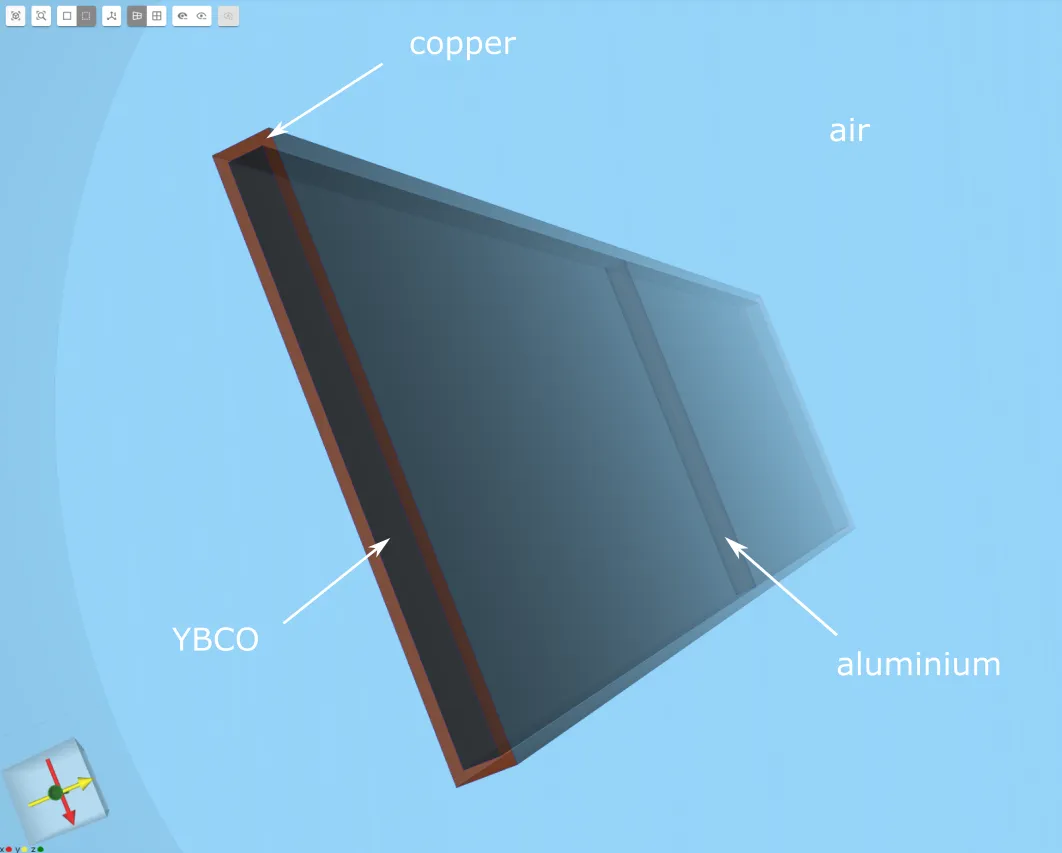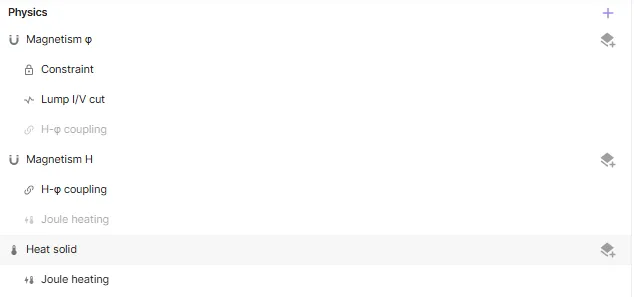SC 003 - Quench
This example is part 3 of the superconductor (SC) tutorial series. Check out the previous parts below:
In this example, the quench event is simulated in a superconducting YBCO tape.
This example corresponds with the demo project Quench - Hello World Demo.
Model definition
Section titled “Model definition”The tape model has a 0.8 mm YBCO core with a 0.2 mm copper coating.
To initiate quench, a high resistivity area is modeled in the YBCO core. This is done by adding an aluminium cylinder at the mid-section of the core.

| Element | XYZ dimensions [mm] | Aligned with axis |
|---|---|---|
| Copper box | 12 x 1.2 x 50 | Z |
| YBCO box | 11.6 x 0.8 x 50 | Z |
| Element | Radius [mm] | Height [mm] | aligned with axis |
|---|---|---|---|
| Air cylinder | 40 | 50 | Z |
| Aluminium cylinder | 0.4 | 11.6 | X |
The center point of each element listed here is at the origin, (0, 0, 0).
Simulation setup guide
Section titled “Simulation setup guide”Here, you’ll find a simplified guide on setting up this simulation in Quanscient Allsolve.
Step 1 - Create the geometry
Section titled “Step 1 - Create the geometry”In the Geometry section, build the copper box, YBCO box, air cylinder and aluminium cylinder as detailed in the Model definition.
Step 2 - Define variables
Section titled “Step 2 - Define variables”Go to the Common sidebar.
-
Define variables:
Name Description Expression Tc Critical temperature [K] 92Top Operating temperature [K] 77
Step 3 - Define the physics, materials and apply boundary conditions
Section titled “Step 3 - Define the physics, materials and apply boundary conditions”Proceed to the Physics section.
Assign the Copper, YBCO superconductor, Aluminium and Air materials to their corresponding volumes.
In this example, we need to make slight changes to the YBCO superconductor material properties, as the predefined YBCO_PowerLaw(j,T) function has the constant current density YBCO_Jc.
-
In a quench simulation, the current density must be a function of temperature, as the resistivity of the YBCO tape increases with temperature.
-
Change the
YBCO_PowerLaw(j)function to use the current densityJcT(T)instead:max(min(JcT(T)/YBCO_Ec * pow(norm(j)/JcT(T), 1.0-YBCO_n), 1e15), 1e6)Add
Tto the powerlaw function arguments.- The function is now called as
YBCO_PowerLaw(j,T). Remember to passTto the function also in YBCO material properties, where the function call is made.
- The function is now called as
-
Define the function
JcT(T)as:YBCO_Jc*ifpositive(T-Tc,1e-3,(Tc-T)/(Tc-Top))
In the Physics section, add the following physics.

Under Magnetism φ, the Constraint target is a top edge point on the air cylinder. The Lump I/V cut target is a loop along the top outer edge of the copper box.
Under Magnetism H, H-φ coupling must be enabled.
Under Heat solid, the Joule heating target is the whole tape volume, with the copper box, YBCO box and aluminium cylinder included.
Step 4 - Set up the simulation, run and plot
Section titled “Step 4 - Set up the simulation, run and plot”Proceed to the Simulations section and add a mesh that suits your needs.
Add a new simulation and choose options. See Superconductor AC loss tutorial for reference. Run the simulation.
Plot Time step in X axis and max T in YBCO in Y axis to see joule heating results.